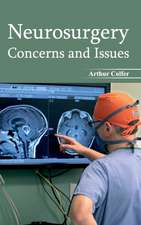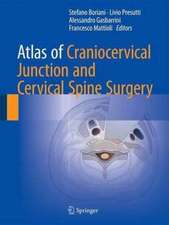Hydrocephalus: Selected Papers from the International Workshop in Crete, 2010: Acta Neurochirurgica Supplement, cartea 113
Editat de Gunes A. Aygok, Harold L. Rekateen Limba Engleză Paperback – 23 aug 2016
The topics covered include advances in management of both pediatric and adult hydrocephalus, identifying shunt responders, clinical experiences in endoscopic third ventriculostomy, clinical trials, pathophysiology, experimental studies, and the new classification for hydrocephalus.
| Toate formatele și edițiile | Preț | Express |
|---|---|---|
| Paperback (1) | 1034.10 lei 6-8 săpt. | |
| SPRINGER VIENNA – 23 aug 2016 | 1034.10 lei 6-8 săpt. | |
| Hardback (1) | 1289.01 lei 38-44 zile | |
| SPRINGER VIENNA – 15 dec 2011 | 1289.01 lei 38-44 zile |
Din seria Acta Neurochirurgica Supplement
- 5%
 Preț: 1798.83 lei
Preț: 1798.83 lei - 5%
 Preț: 1445.88 lei
Preț: 1445.88 lei - 5%
 Preț: 1102.31 lei
Preț: 1102.31 lei - 5%
 Preț: 1136.85 lei
Preț: 1136.85 lei - 5%
 Preț: 811.16 lei
Preț: 811.16 lei - 5%
 Preț: 1112.70 lei
Preț: 1112.70 lei - 5%
 Preț: 529.80 lei
Preț: 529.80 lei - 5%
 Preț: 791.25 lei
Preț: 791.25 lei - 5%
 Preț: 1303.26 lei
Preț: 1303.26 lei - 5%
 Preț: 410.88 lei
Preț: 410.88 lei - 5%
 Preț: 345.70 lei
Preț: 345.70 lei - 5%
 Preț: 1316.08 lei
Preț: 1316.08 lei - 5%
 Preț: 1452.28 lei
Preț: 1452.28 lei - 5%
 Preț: 1348.46 lei
Preț: 1348.46 lei - 5%
 Preț: 370.94 lei
Preț: 370.94 lei - 5%
 Preț: 376.22 lei
Preț: 376.22 lei - 5%
 Preț: 715.00 lei
Preț: 715.00 lei - 5%
 Preț: 364.17 lei
Preț: 364.17 lei - 5%
 Preț: 365.82 lei
Preț: 365.82 lei - 5%
 Preț: 366.91 lei
Preț: 366.91 lei - 5%
 Preț: 384.08 lei
Preț: 384.08 lei - 5%
 Preț: 397.16 lei
Preț: 397.16 lei - 5%
 Preț: 367.64 lei
Preț: 367.64 lei - 5%
 Preț: 373.12 lei
Preț: 373.12 lei - 5%
 Preț: 993.11 lei
Preț: 993.11 lei - 5%
 Preț: 394.07 lei
Preț: 394.07 lei - 5%
 Preț: 364.74 lei
Preț: 364.74 lei - 5%
 Preț: 1095.90 lei
Preț: 1095.90 lei - 5%
 Preț: 1824.06 lei
Preț: 1824.06 lei - 5%
 Preț: 1119.31 lei
Preț: 1119.31 lei - 5%
 Preț: 1312.09 lei
Preț: 1312.09 lei - 5%
 Preț: 1119.68 lei
Preț: 1119.68 lei - 5%
 Preț: 1331.76 lei
Preț: 1331.76 lei - 5%
 Preț: 1430.72 lei
Preț: 1430.72 lei - 5%
 Preț: 1405.49 lei
Preț: 1405.49 lei - 5%
 Preț: 1418.48 lei
Preț: 1418.48 lei - 5%
 Preț: 392.25 lei
Preț: 392.25 lei - 5%
 Preț: 1335.44 lei
Preț: 1335.44 lei - 5%
 Preț: 1375.20 lei
Preț: 1375.20 lei
Preț: 1034.10 lei
Preț vechi: 1088.52 lei
-5% Nou
Puncte Express: 1551
Preț estimativ în valută:
197.89€ • 205.35$ • 165.41£
197.89€ • 205.35$ • 165.41£
Carte tipărită la comandă
Livrare economică 18 martie-01 aprilie
Preluare comenzi: 021 569.72.76
Specificații
ISBN-13: 9783709119358
ISBN-10: 3709119359
Pagini: 198
Ilustrații: XII, 198 p.
Dimensiuni: 210 x 279 mm
Greutate: 0.49 kg
Ediția:Softcover reprint of the original 1st ed. 2012
Editura: SPRINGER VIENNA
Colecția Springer
Seria Acta Neurochirurgica Supplement
Locul publicării:Vienna, Austria
ISBN-10: 3709119359
Pagini: 198
Ilustrații: XII, 198 p.
Dimensiuni: 210 x 279 mm
Greutate: 0.49 kg
Ediția:Softcover reprint of the original 1st ed. 2012
Editura: SPRINGER VIENNA
Colecția Springer
Seria Acta Neurochirurgica Supplement
Locul publicării:Vienna, Austria
Cuprins
I Importance of the Work of Professor Marmarou.- 5th International Hydrocephalus Workshop, Crete, Greece, May 20-23, 2010: Themes and Highlights.- Modelling of CSF Dynamics – Legacy of Professor Anthony Marmarou.- II Importance of Data, Especially from Randomized Controlled Trials.- Ethical Considerations in Hydrocephalus Research that Involves Children and Adults.- Conservative versus Surgical Management of Idiopathic Normal Pressure Hydrocephalus: a prospective randomized controlled double blind trial; study protocol.- Ten Years of Clinical Experience in the Use of Fixed-Pressure vs. Programmable Valves: A Retrospective Study of 159 Patients.- III Magnetic Resonance Imaging as a Powerful Tool.- Changes of fractional anisotropy (FA) and apparent diffusion coefficient (ADC) in patients with idiopathic normal pressure hydrocephalus.- Virchow-Robin spaces in idiopathic normal pressure hydrocephalus: A surrogate imaging marker for co-existing microvascular disease?.- Quantification of normal CSF flow through the aqueduct using PC-Cine MRI at 3T.- Correlation between tap test and CSF aqueductal stroke volume in idiopathic normal pressure hydrocephalus.- IV Basic Science: The Aquaporin Story.- Overview of the CSF dual outflow system.- Hydrocephalus and aquaporins. The role of aquaporin-1.- Hydrocephalus and aquaporins. The role of aquaporin-4.- Acetazolamide-induced Decrease of Apical Fluid Flow in Choroid Plexus is Associated with Nonessential Changes in Aquaporin-1 Expression.- V Experimental Studies: Hydrocephalus.- Physical phantom of cranio-spinal hydrodynamics.- Programmable Shunt Assistant tested in Cambridge Shunt Evaluation Laboratory.- Simulation of existing and future electromechanical shunt valves in combination with a model for brain fluid dynamics.- Examination of deposits in Cerebrospinal Fluid shunt valves using ScanningElectron Microscopy.- Microstructural alterations of silicone catheters in an animal experiment: histopathology and SEM-findings.- Expression analysis of High Mobility Group Box-1 Protein (HMGB-1) in the cerebral cortex , hippocampus , cerebellum of the congenital hydrocephalus rat (H-Tx rat).- Brain Localization of Leucine-Rich α2 Glycoprotein and its Role.- Role of artificial cerebrospinal fluid as perfusate in neuroendoscopic surgery: A basic investigation.- Subdural or intraparenchymal placement of long-term telemetric ICP- measurement-devices?.- VI Clinical Studies: Hydrocephalus.- A twelve-year hospital outcome on patients with idiopathic hydrocephalus.- What is the appropriate shunt system for Normal Pressure Hydrocephalus?.- Indications for endoscopic third ventriculostomy in normal pressure hydrocephalus.- The Role of Endoscopic Third Ventriculostomy in the Treatment of Selected Patients with Normal Pressure Hydrocephalus.- Endoscopic third ventriculostomy in obstructive hydrocephalus. Surgical technique and pitfalls.- Benign cerebral aqueduct stenosis in an adult.- Efficacy and versatility of the 2-micron continuous wave laser in neuroendoscopic procedures.- Complications of endoscopic third ventriculostomy. A meta-analysis.- Syndrome of inappropriately low-pressure acute hydrocephalus (silpah)* (* previously known as negative-pressure hydrocephalus).- Lhermitte-Duclos disease presenting with hydrocephalus.- Atypical meningioma in the posterior fossa associated with colpocephaly and agenesis of the corpus callosum.- The management of the intraventricular hemorrhage in preterm infant with low birth weight.- Pathophysiology of Brain Stem Lesions Due to Overdrainage.- Dynamics of CSF flow in slit ventricle syndrome.- Quality and safety of home ICP monitoring compared to in-hospitalmonitoring.-
Recenzii
From the reviews:
“This book presents recent updates and new concepts in the treatment of hydrocephalus from the fifth international workshop in Crete, Greece, May 20-23, 2010. … The audience includes adult and pediatric neurosurgeons and neurologists, family practitioners, biomedical personal, and neuroradiologists. It is good for university and department libraries. … This is a major contribution to the literature on the progress in the management of adult and pediatric hydrocephalus. It is timely and written by well-known authors in the field.” (Ramsis Farid Ghaly, Doody’s Review Service, June, 2012)
“This book presents recent updates and new concepts in the treatment of hydrocephalus from the fifth international workshop in Crete, Greece, May 20-23, 2010. … The audience includes adult and pediatric neurosurgeons and neurologists, family practitioners, biomedical personal, and neuroradiologists. It is good for university and department libraries. … This is a major contribution to the literature on the progress in the management of adult and pediatric hydrocephalus. It is timely and written by well-known authors in the field.” (Ramsis Farid Ghaly, Doody’s Review Service, June, 2012)
Textul de pe ultima copertă
The contributions in this volume, presented at the 5th International Hydrocephalus Workshop in May 2010 in Crete, Greece, give the present state-of-the-art in timely diagnosis and treatment of hydrocephalus.The topics covered include advances in management of both pediatric and adult hydrocephalus, identifying shunt responders, clinical experiences in endoscopic third ventriculostomy, clinical trials, pathophysiology, experimental studies, and the new classification for hydrocephalus.
Caracteristici
Advances in management of both pediatric and adult hydrocephlaus Introducing the new classification for hydrocephalus Includes supplementary material: sn.pub/extras













